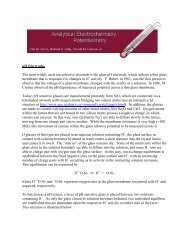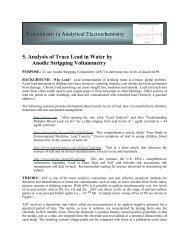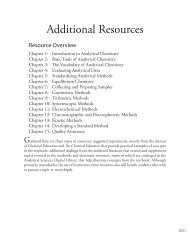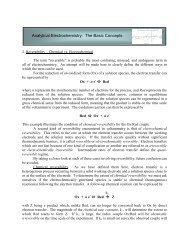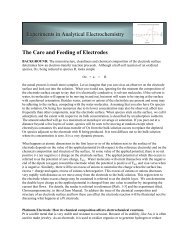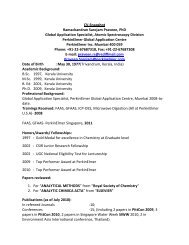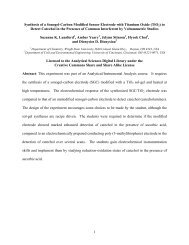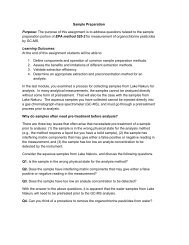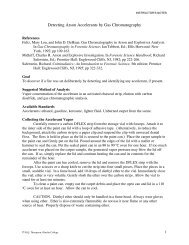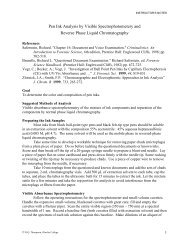Chapter 5 - Analytical Sciences Digital Library
Chapter 5 - Analytical Sciences Digital Library
Chapter 5 - Analytical Sciences Digital Library
You also want an ePaper? Increase the reach of your titles
YUMPU automatically turns print PDFs into web optimized ePapers that Google loves.
158 <strong>Analytical</strong> Chemistry 2.0<br />
assumed relationship<br />
actual relationship<br />
S samp<br />
Figure 5.2 Example showing how a single-point<br />
standardization leads to a determinate error in an<br />
analyte’s reported concentration if we incorrectly<br />
assume that the value of k A is constant.<br />
S std<br />
C std<br />
(C A ) reported<br />
(C A ) actual<br />
C std is known as a calibration curve. The exact standardization, or calibration<br />
relationship is determined by an appropriate curve-fitting algorithm.<br />
There are at least two advantages to a multiple-point standardization.<br />
First, although a determinate error in one standard introduces a determinate<br />
error into the analysis, its effect is minimized by the remaining standards.<br />
Second, by measuring the signal for several concentrations of analyte we<br />
no longer must assume that the value of k A is independent of the analyte’s<br />
concentration. Constructing a calibration curve similar to the “actual relationship”<br />
in Figure 5.2, is possible.<br />
Appending the adjective “external” to the<br />
noun “standard” might strike you as odd<br />
at this point, as it seems reasonable to assume<br />
that standards and samples must<br />
be analyzed separately. As you will soon<br />
learn, however, we can add standards to<br />
our samples and analyze them simultaneously.<br />
5C.2 External Standards<br />
The most common method of standardization uses one or more external<br />
standards, each containing a known concentration of analyte. We call<br />
them “external” because we prepare and analyze the standards separate from<br />
the samples.<br />
Si n g l e Ex t e r n a l St a n d a r d<br />
A quantitative determination using a single external standard was described<br />
at the beginning of this section, with k A given by equation 5.5. After determining<br />
the value of k A , the concentration of analyte, C A , is calculated<br />
using equation 5.6.<br />
Example 5.1<br />
A spectrophotometric method for the quantitative analysis of Pb 2+ in<br />
blood yields an S std of 0.474 for a single standard whose concentration of<br />
lead is 1.75 ppb What is the concentration of Pb 2+ in a sample of blood<br />
for which S samp is 0.361



